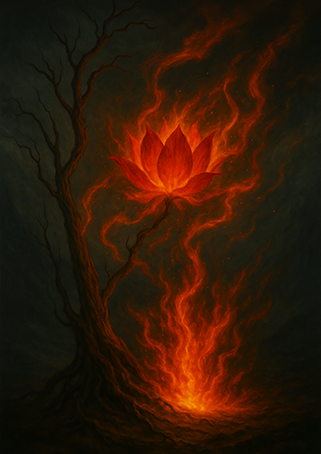Xieyi・The Rootless Tree:100 Verses-Verse 31#305

The poems of “The Rootless Tree” express a fundamental force rooted in harmony with heaven and earth, the cyclical flow of yin and yang, and the infinite potential of existence。
This painting is an expressive “Xieyi” in the tradition of “futu” (spiritual diagrams), passed down for generations in Wudang Mountain, China. It is drawn through a technique where energy flow (xingqi) channels the internal intention into visual form。 In the Taoist world, there exist spiritual and symbolic images called “futu”。
In the Taoist world, there exist spiritual and symbolic images called “futu”。
These are a type of talisman—not merely religious items, but expressive spiritual paintings that act directly on the mind of the viewer。
Since ancient times, many people have placed these Taoist-style “Xieyi” and futu in their homes, studies, or bedrooms, wishing for longevity, health, auspiciousness, and family harmony. Viewing such paintings was not just aesthetic appreciation, but an act of inviting the presence of the Dao into one’s life and tuning the body and mind。
Thus, “Xieyi” is more than artistic expression—it is a medium that bridges the spirit, life, and harmony with the universe。
This kind of artwork is not meant to be seen only with the eyes, but felt with the heart。
It communicates with the Dao, resonates with the qi of nature, and quietly stirs the viewer’s inner self。
Futu and “Xieyi” continue to live on from ancient times to this day as “sacred images that speak to the soul.”
Below, we present the original text of the philosophical poem “The Rootless Tree,” along with a modern Japanese translation and interpretation。
※ The author of “The Rootless Tree,” Zhang Sanfeng (1247–?), is also renowned as the founder of Tai Chi, and it is said that he applied the essence of this work to Tai Chi. As an additional note, we include an interpretation connecting this to the Tai Chi tradition of Wudang Mountain.
Details of Tao Code, Feng Shui and talismans in Xieyi Painting
In the visual composition, the fierce scarlet bloom rises from dense black ink, then dissolves into soft gray mists and pale gold glimmers. The painting evokes the cycle of burning passion and silent transcendence, inviting the viewer into the space where form dissolves and the spirit walks freely.
This piece embodies Ascending Void Qi (Sheng Xu Qi) — the formation of emptiness through transcendence, the liberation of energy into space. It is suited to spaces of reflection and renewal: a quiet study, a contemplative lounge, or the foyer of a mindful home. The gold tones align with the Metal element, symbolizing clarity and precision, while the shift from dark to light purges stagnation and opens transformation.
May this painting serve as a silent talisman — a vessel of transformation where fire becomes void and the spirit walks free under Heaven’s decree.
The Rootless Tree・Verse 31

▶Original Text
無根樹,花正紅,烈焰吞噬即成空。無悔無怨無所懼,自在行走任天命。
▶Modern Translation
A scarlet bloom flares on a rootless tree;
Devouring fire turns to emptiness at once.
No regret, no resentment, nothing to fear—
Freely it walks, entrusted to Heaven’s decree.
▶Interpretation
1.[無根樹,花正紅] – Crimson flower = fierce but fleeting passion.
2.[烈焰吞噬即成空] – Fire consumes, leaving only “void” (śūnyatā).
3.[無悔無怨無所懼] – Living without regret, grievance, or fear.
4.[自在行走任天命] – Roams at ease, aligned with the Dao and fate.
▶Interpretation related to Tai Chi
•Fajin flashes like a red flame, then vanishes to “emptiness.”
•Release power and instantly return to neutrality.
•Emotion-free focus = “no mind, no fear.”
•Follow the flow of present circumstances—adaptive spontaneity.
Copyright © MASAKI WAKABAYASHI. All rights reserved.




